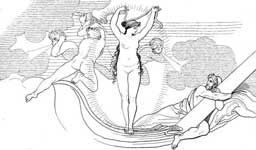.

In Greek mythology, Leucothea (Leukothea )(Greek the "White Goddess") was one of the aspects under which an ancient sea goddess was recognized. Mythic themes agree that she was a transformed nymph.
In the more familiar variant, Ino, the sister of Semele and queen of Athamas became a goddess after Hera drove her insane as a punishment for caring for the new-born Dionysus. Ino/Leucothea leapt into the sea, with her son Melicertes in her arms. Out of pity, the Hellenes asserted, the Olympian gods turned them both into sea-gods, transforming Melicertes into Palaemon, the patron of the Isthmian games that were held in his honour. See Ino for more details.
In Rhodes, a much earlier mythic level can be detected. There, the woman who plunged into the sea and became Leucothea was Halia ("of the sea"), a local nymph and one of the aboriginal Telchines of the island, who succumbed to Poseidon, nurtured on the island. Halia bore him Rhodos/Rhode and six sons; the sons were maddened by Aphrodite in retaliation for an impious affront, assaulted their sister and were confined beneath the Earth by Poseidon. Thus the Rhodians traced their mythic descent from Rhode and the titan Helios. (Graves 1955)
In the Odyssey Leucothea makes a dramatic appearance as a sea-mew who offers the shipwrecked Odysseus a veil to wind round himself to save his life in the sea. Homer makes her the transfiguration of Ino.
Leucothea is The White Goddess of Robert Graves.
The Etruscan Losna may well be comparable.
There was also a mortal woman in Greek mythology named Leucothoë: a mortal princess, daughter of Orchamus and sister of Clytia, Leucothoë loved Apollo, who disguised himself as Leucothea's mother to gain entrance to her chambers. Clytia, jealous of her sister because she wanted Apollo for herself, told Orchamus the truth, betraying her sister's trust and confidence in her. Enraged, Orchamus ordered Leucothoë buried alive. Apollo refused to forgive Clytia for betraying his beloved, and a grievous Clytia wilted and slowly died. Apollo changed her into an incense plant, either heliotrope or sunflower, which follows the sun every day.
— Pausanias, 2.2.1
Within the sanctuary of Poseidon at Isthmia, Pausanias saw a temple of Palaemon, "with images in it of Poseidon, Leucothea and Palaemon himself".
References
Greek Religion, Walter Burkert
The Greek Myths: The Complete And Definitive Edition, Robert Graves
Gods of the Greeks, Carl Kerenyi
See also : Greek Mythology. Paintings, Drawings
| Ancient Greece
Science, Technology , Medicine , Warfare, , Biographies , Life , Cities/Places/Maps , Arts , Literature , Philosophy ,Olympics, Mythology , History , Images Medieval Greece / Byzantine Empire Science, Technology, Arts, , Warfare , Literature, Biographies, Icons, History Modern Greece Cities, Islands, Regions, Fauna/Flora ,Biographies , History , Warfare, Science/Technology, Literature, Music , Arts , Film/Actors , Sport , Fashion --- |
Retrieved from "http://en.wikipedia.org"
All text is available under the terms of the GNU Free Documentation License

